A couple of years ago, then Pixar storyboard artist Emily Coats tweeted pieces of advice on making stories that she had picked up from working with Pixar, which were later compiled on in several places on the internet, such as this io9 post. Later, Dino Ignacio created image macros of the individual rules which I am using in these posts.
Rule #4: “Once upon a time there was ___. Every day, ___. One day ___. Because of that, ___. Because of that, ___. Until finally ___.”
What we have here is a very useful basic structure. It is flexible enough to be used for a variety of purposes, from describing character backstories to setting up plots. The first two sentences set context, the third introduces an agent of change, and the remaining sentences describe the results.
I often use something like this when setting up plots for sessions. Sometimes I start at the beginning: Once upon a time, there was a village next to a forest. Every day, the villagers would chop and mill lumber to send to the city. One day, a lumberjack discovered a beautiful silver tree. Because of that, the villagers started arguing over whether they should cut it down and sell the wood, and if so, who gets the money? Because of that, an atmosphere of suspicion and resentment develops, with many villagers plotting against each other. Until finally, the lumberjack is murdered.
You can insert the players into this wherever you want. Maybe the “Until finally” is what draws the players into the story; a murder is reported and their characters are asked to investigate. Maybe the PC’s come in in the middle of the “Because of thats” and the “Until finally” is what would have happened in they didn’t arrive, and what might still happen if they don’t figure out what’s wrong in time. Or maybe the PC’s themselves are the “One day” event: They are simply passing through town, but their mere arrival sets off a chain of events that disrupts the village.
This form is also useful when you want to design an antagonist or their schemes. Start at the end point, who the antagonist is now or what they are trying to bring about, and work backwards. What sequence of events made your antagonist what they are at the start of the story? Who were they at the start? If your antagonist’s end goal is ruling the criminal underworld, how do they plan to get there from where they are now? Once you have a plan for your antagonist, you can look for interesting places to have the players brush up against it, where they can end up disrupting it or being used to further it. This also gives you an idea of of hints and rumors you can drop to foreshadow your antagonist’s rise and clue the players in that something big is happening. If the first step in your antagonist’s plan is to merge the Thieves’ Guild with the Assassin’s Guild, then your players might hear rumors or see evidence of thieves and assassins sharing information or working together.
Finally, as a player, this is a useful rubric for writing a basic backstory that can be fleshed out as needed. Once again, you can start at the end, defining the “Until finally” as the point they are at when the story begins and filling out the details of how they got there. What was your character like at the start of it all? What was the routine of their life? What changed to throw them off what they thought their trajectory was and how has that event reverberated throughout their life? The GM can help this process (and help themselves) by cluing in the players on where and how they want the game to start to help set the parameters, such as location or organizations the PC’s might be working with, of the “Until finally.”
When it comes down to it, this rule is a reminder to pay attention to narrative causality. Whether you are planning an adventure or crafting a character, remember to make sure events flow from one to the next in a way that makes sense, even if the characters in the story can’t make sense of it themselves.





